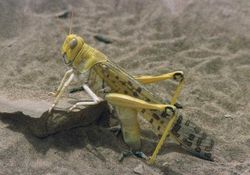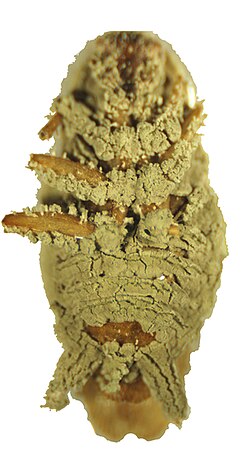LUBILOSA was the name of a research programme that aimed at developing a biological alternative to the chemical control of locusts. This name is an acronym...
31 KB (4,347 words) - 21:00, 18 January 2025
near rivers and other water bodies. Green Muscle was developed under the LUBILOSA programme, which was initiated in 1989 in response to environmental concerns...
64 KB (8,356 words) - 17:00, 11 April 2025
Society German Society for Orthopterology Journal of Orthoptera Research LUBILOSA This ultimately derives from Greek -λογία, but via Latin -logia and French...
2 KB (135 words) - 09:55, 14 March 2025
Australian Plague Locust Commission List of locust swarms Locust (ethnic slur) LUBILOSA – Locust research programme Periodical cicadas The American locust (Schistocerca...
55 KB (5,778 words) - 19:57, 12 May 2025
[citation needed] Fungus - Wikipedia Biopesticide Entomopathogenic nematode LUBILOSA and Desert locust for more on use of Metarhizium as a biological insecticide...
27 KB (2,940 words) - 15:42, 27 March 2025
acridum. The latter is based on technology developed by CSIRO and the LUBILOSA programme, and now accounts for more than 12% of spray applications: for...
13 KB (1,316 words) - 22:01, 15 November 2024
locusts and other grasshopper pest species: originally by the international LUBILOSA programme (which developed the product Green Muscle). This team identified...
8 KB (677 words) - 09:50, 15 February 2025
Bioherbicide Biological pest control Cembratrienol Integrated Pest Management LUBILOSA Pest resistance management plans Plant defense against herbivory Use as...
17 KB (1,915 words) - 19:29, 31 March 2025
(= ARSEF 7493) and FI 1045 which is the active ingredient of 'Biocane'. LUBILOSA Beauveria bassiana, the fungus that causes white muscardine disease in...
9 KB (919 words) - 21:49, 29 September 2024
Marshlands Initiative. For example, CIDA was a major donor to the International LUBILOSA Programme: which developed a biological pesticide for locust control, in...
7 KB (671 words) - 17:27, 12 January 2025
development of a biological pesticide in collaboration with CSIRO and LUBILOSA scientists. It also conducts educational outreach and training courses...
5 KB (465 words) - 12:22, 16 May 2025
to water sources due to risk of their contamination. In the 1990s, the LUBILOSA research programme proved that M. acridum in its spore form was effective...
15 KB (1,555 words) - 17:19, 26 April 2025
for the poor. For example, SDC was a major donor to the International LUBILOSA Programme: which developed a biological pesticide for locust control, in...
9 KB (847 words) - 10:18, 23 April 2025
research effort. For example, the DFID was a major donor to the International LUBILOSA programme, which developed a biological pesticide for locust control in...
48 KB (3,568 words) - 07:22, 28 February 2025
(see desert locust). Large-scale field tests on O. senegalensis, by the LUBILOSA Programme in 1995-97, were amongst the first successful large-scale field...
6 KB (714 words) - 21:26, 25 October 2024
demonstrations of efficacy took place in northern Benin, with field tests by the LUBILOSA Programme on H. daganensis. The Northern Dogon people of Mopti Region,...
7 KB (654 words) - 01:19, 30 September 2023
on the entomopathogenic fungus (Metarhizium acridum), was tested by the LUBILOSA Programme in collaboration with the South African Plant Protection Institute:...
4 KB (437 words) - 19:07, 23 June 2024
two sites as CABI Bioscience. The Silwood site was the centre for the LUBILOSA Programme, where an inter-disciplinary team could be set up, combining...
11 KB (1,203 words) - 17:10, 1 March 2025
that references to this species for control of locusts (e.g. in early LUBILOSA Programme literature) should apply to Metarhizium acridum. Historically...
13 KB (1,310 words) - 03:57, 28 April 2024
valuable in the development of biological pesticides (e.g. participation in LUBILOSA). Making application technology more accurate - research on development...
5 KB (528 words) - 20:38, 14 August 2024













